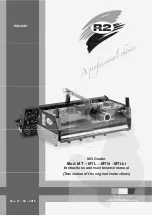
F 002 DG9 918
2017-10-16
|
Bosch Limited
12 | EPS 610 | Product description
en
3.8
Temperature control for VE pumps
Because of the overflow throttle, there is significant
heat generation when a VE pump is in operation. When
larger VE pumps are operated at high speeds, the over-
flow temperature rises quickly. There is some delay in
reducing the temperature within limits. To facilitate
quicker cooling, the flushing valve is used.
Pressing the flushing valve causes the overflow oil to
flow to the tank. This reduces the heat generation in
the pump enabling a quicker reduction in overflow tem-
perature.
!
Do not press the flushing valve during measurement
of injected and overflow quantity. This will lead to
wrong results.
3.9
Power supply for start / stop valve
(12/24 V for distributor pumps)
!
Never connect two or more items of electrical equip-
ment
(e.g.
solenoid valve) to the 12/24 V supply
terminals of the EPS 610, as this could damage the
electrical equipment!
!
Never disconnect or connect electrical equipment
with the EPS 610 switched on.
!
The operating current should not exceed 5 A.
458877_58Nkv
1
2
Fig. 10: Front panel
1 Power supply sockets
2 Test oil pressure regulator
For operation of the pump solenoid, a set of cables (red
and black) and crocodile clips are provided. These can
be used for connection to any one of the sockets based
on the pump type to be tested.
i
Ensure that the crocodile clips do not short. Else,
the Miniature Circuit Breaker (MCB) in the electrical
cabinet (F5 for 12 V and F6 for 24 V) will trip. Switch
on the MCB (F5 for 12 V and F6 for 24 V) in case it
trips.
3.6.2
Heating the test oil
The test oil is heated by an electrical resistance heater
installed in the test oil tank.
i
To prevent the risk of fire due to overheating of test
oil, adequate safety measures have been provided.
The time required for heating the test oil from room
temperature to 40 °C depends on the amount of test oil
in the tank.
When the <Test oil pump on / off> key is switched on,
the heater and water inlet valve are used for maintain-
ing the oil temperature at the inlet / outlet (depending
on the user selection). The temperature sensors con-
tinuously monitor the temperature. The temperature
values are also displayed on the HMI display.
3.7
Temperature measurement and control
As soon as the drive motor is switched on, the test oil
temperature is regulated by way of the heating and the
water control valve.
i
For fuel injection pumps of a certain size, the test
oil warms up while testing the fuel injection pumps
and hence, no additional heating is required. In case
of larger fuel injection pumps, heating the test oil
causes the temperature to exceed beyond the pre-
scribed limit. It is then necessary to cool the test oil.
Fuel injection pumps should be calibrated only when
the test oil is heated within the specified tempera-
ture limits.
The heat exchanger supplies enough cooling water so
that the preset test oil temperature is maintained. If
test oil heating is on and the temperature in the test oil
tank exceeds 70°C, the EPS 610 initiates emergency
automatically.
The EPS 610 can be restarted and the test oil heating
can be switched on again after the temperature of the
test oil reduces below 70°C.
i
If the temperature sensor is not connected or is
damaged, an error message is displayed
.
Refer to
chapter 7 for the list of error messages.
Summary of Contents for EPS 610
Page 1: ...EPS 610 en Original instructions Injection pump test bench ...
Page 2: ......
Page 34: ......
Page 35: ......













































